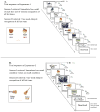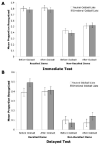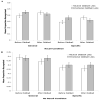Reconciling findings of emotion-induced memory enhancement and impairment of preceding items
- PMID: 20001121
- PMCID: PMC2917000
- DOI: 10.1037/a0017281
Reconciling findings of emotion-induced memory enhancement and impairment of preceding items
Abstract
A large body of work has revealed that people remember emotionally arousing information better than neutral information. However, previous research has revealed contradictory effects of emotional events on memory for neutral events that precede or follow them: In some studies, emotionally arousing items have impaired memory for immediately preceding or following items, and in others arousing items enhanced memory for preceding items. By demonstrating both emotion-induced enhancement and impairment, Experiments 1 and 2 clarified the conditions under which these effects are likely to occur. The results suggest that emotion-induced enhancement is most likely to occur for neutral items that (a) precede (and so are poised to predict the onset of) emotionally arousing items, (b) have high attentional weights at encoding, and (c) are tested after a delay period of a week rather than within the same experimental session. In contrast, emotion-induced impairment is most likely to occur for neutral items near the onset of emotional arousal that are overshadowed by highly activated competing items during encoding.
Figures








Similar articles
-
The role of attention in the associative binding of emotionally arousing words.Psychon Bull Rev. 2012 Dec;19(6):1128-34. doi: 10.3758/s13423-012-0315-x. Psychon Bull Rev. 2012. PMID: 23055140
-
Emotion enhances remembrance of neutral events past.Proc Natl Acad Sci U S A. 2006 Jan 31;103(5):1599-604. doi: 10.1073/pnas.0506308103. Epub 2006 Jan 24. Proc Natl Acad Sci U S A. 2006. PMID: 16434476 Free PMC article.
-
Emotion strengthens high-priority memory traces but weakens low-priority memory traces.Psychol Sci. 2014 Feb;25(2):387-95. doi: 10.1177/0956797613504784. Epub 2013 Dec 5. Psychol Sci. 2014. PMID: 24311478 Free PMC article.
-
Memory for emotionally arousing items: context preexposure enhances subsequent context-item binding.Emotion. 2014 Jun;14(3):611-4. doi: 10.1037/a0034017. Epub 2013 Sep 16. Emotion. 2014. PMID: 24040884
-
Children's recall of emotionally arousing, repeated events: a review and call for further investigation.Int J Law Psychiatry. 2008 Aug-Sep;31(4):337-46. doi: 10.1016/j.ijlp.2008.06.002. Epub 2008 Jul 21. Int J Law Psychiatry. 2008. PMID: 18640723 Review.
Cited by
-
Threat of punishment motivates memory encoding via amygdala, not midbrain, interactions with the medial temporal lobe.J Neurosci. 2012 Jun 27;32(26):8969-76. doi: 10.1523/JNEUROSCI.0094-12.2012. J Neurosci. 2012. PMID: 22745496 Free PMC article.
-
Memory modulation: Dominance of negative visual context over neutral verbal memory.PLoS One. 2024 Oct 14;19(10):e0312042. doi: 10.1371/journal.pone.0312042. eCollection 2024. PLoS One. 2024. PMID: 39401222 Free PMC article.
-
States of epistemic curiosity interfere with memory for incidental scholastic facts.NPJ Sci Learn. 2024 Mar 18;9(1):22. doi: 10.1038/s41539-024-00234-w. NPJ Sci Learn. 2024. PMID: 38499583 Free PMC article.
-
Low Arousal Positive Emotional Stimuli Attenuate Aberrant Working Memory Processing in Persons with Mild Cognitive Impairment.J Alzheimers Dis. 2017;60(4):1333-1349. doi: 10.3233/JAD-170233. J Alzheimers Dis. 2017. PMID: 29060938 Free PMC article.
-
Noradrenergic mechanisms of arousal's bidirectional effects on episodic memory.Neurobiol Learn Mem. 2017 Jan;137:1-14. doi: 10.1016/j.nlm.2016.10.017. Epub 2016 Nov 2. Neurobiol Learn Mem. 2017. PMID: 27815214 Free PMC article. Clinical Trial.
References
-
- Adolphs R. Emotional vision. Nature Neuroscience. 2004;7:1167–1168. - PubMed
-
- Adolphs R, Cahill L, Schul R, Babinsky R. Impaired declarative memory for emotional material following bilateral amygdala damage in humans. Learning & Memory. 1997;4:291–300. - PubMed
-
- Adolphs R, Denburg NL, Tranel D. The amygdala's role in long-term declarative memory for gist and detail. Behavioral Neuroscience. 2001;115:983–992. - PubMed
-
- Adolphs R, Tranel D, Buchanan TW. Amygdala damage impairs emotional memory for gist but not details of complex stimuli. Nature Neuroscience. 2005;8:512–518. - PubMed
-
- Anderson A. Affective influences on the attentional dynamics supporting awareness. Journal of Experimental Psychology: General. 2005;134:258–281. - PubMed

